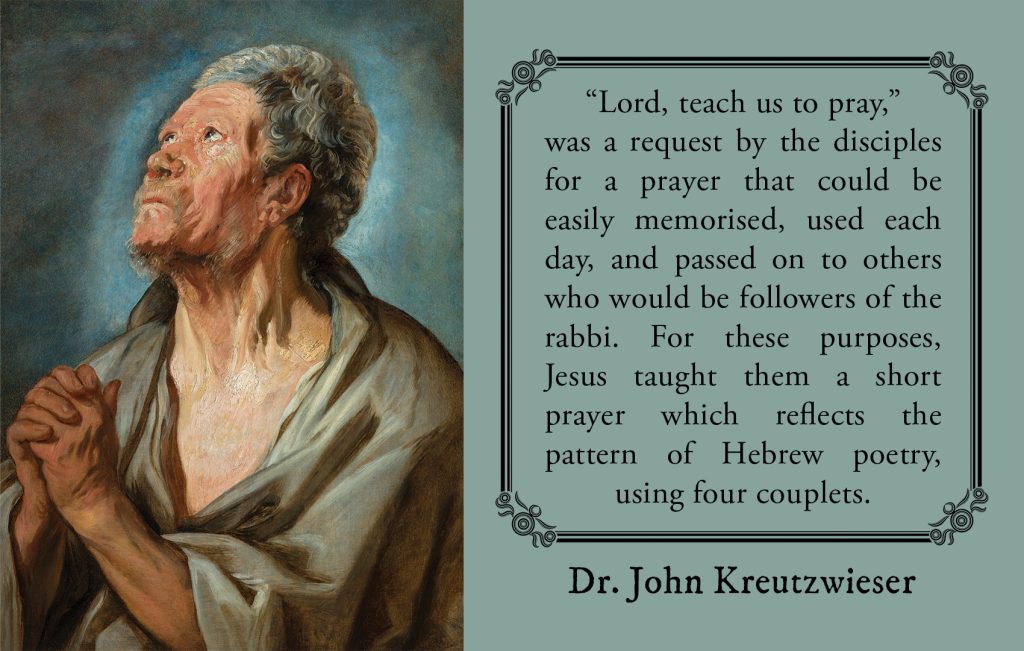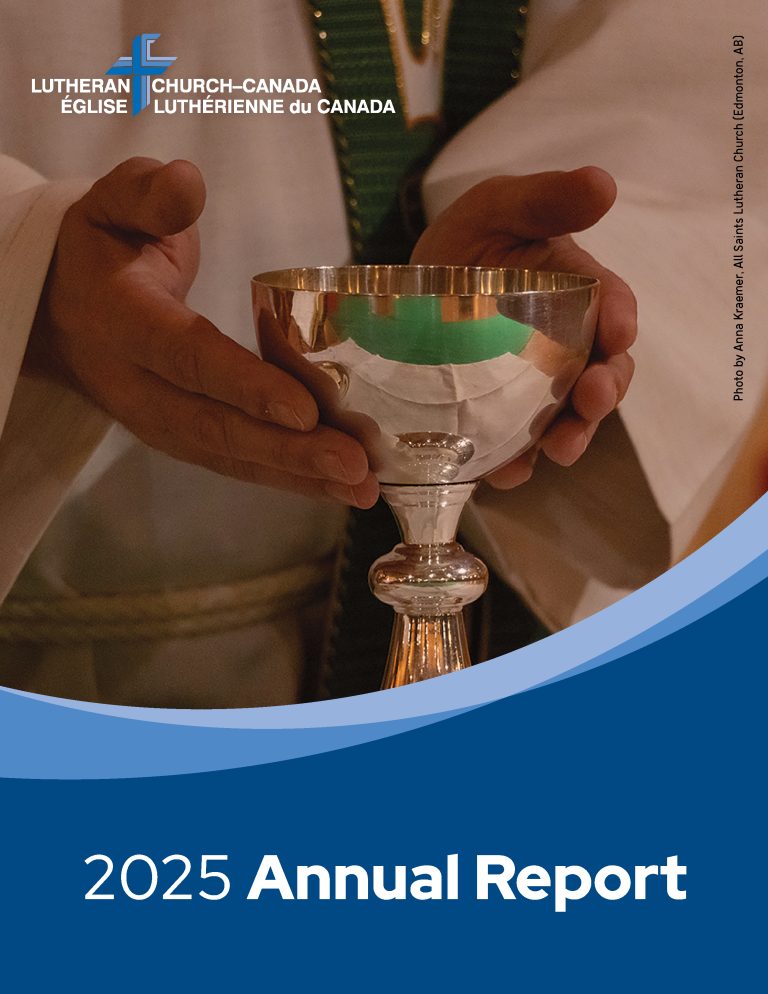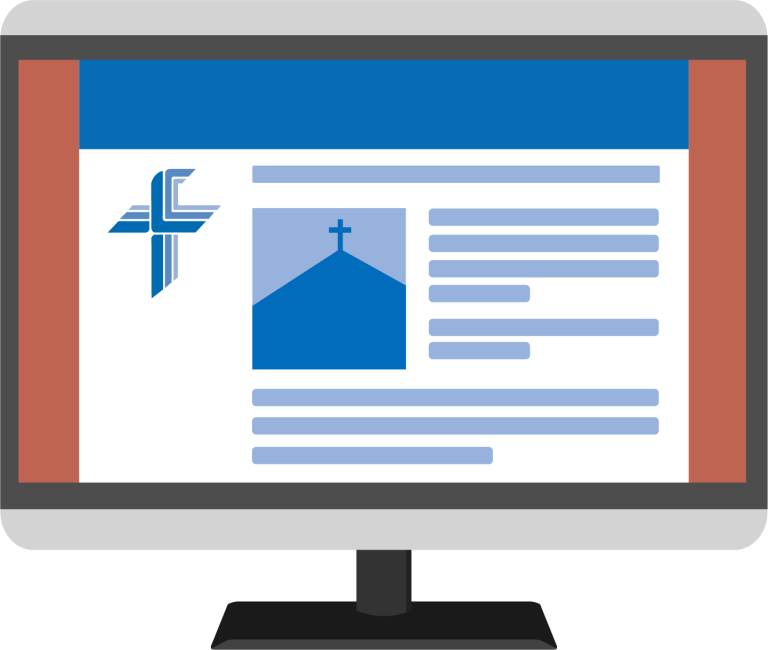Looking at the Lord’s Prayer Another Way
 by John Kreutzwieser
by John Kreutzwieser
“Now Jesus was praying in a certain place, and when He finished, one of His disciples said to Him, ‘Lord, teach us to pray, as John taught his disciples.’ And Jesus said to them, ‘When you pray, say:…” (Luke 11:1-2)
It was typical during the time of Jesus for rabbis to develop short statements and poetic psalms that would be memorised by their students for daily prayer and reflection.
As a first century Jewish child, Jesus grew up with Hebrew poetry and prayers, learned from Scripture (e.g., in the Psalms) and from local rabbis. Hebrew and Aramaic poetry employ a different structure from many English poems. “Mary had a little lamb, its fleece was white as snow; And everywhere that Mary went, the lamb was sure to ____.” Most can fill in the blank without much thought. We are familiar with poems and prayers which are governed by rhyme and metre. Many of our church hymns make use of rhyming words and have a specific metre. (Just have a look at any hymnal.)
Hebrew poetry is dissimilar. It is structured most often by couplets. A couplet is two successive lines of verse forming a unit. The basic Hebrew poetic unit is thought-based. Thought-based couplets introduce the concept in the first line, then the second line completes the thought, repeats the thought in different words, or contrasts the thought. Many of the Psalms and sayings in Proverbs are written this way.
These couplets gave a summary of His teachings and supported faith in God. We know these poetic verses as the Lord’s Prayer.
“Lord, teach us to pray,” was a request by the disciples for a prayer that could be easily memorised, used each day, and passed on to others who would be followers of the rabbi. For these purposes, Jesus taught them a short prayer which reflects the pattern of Hebrew poetry, using four couplets. These couplets gave a summary of His teachings and supported faith in God. We know these poetic verses as the Lord’s Prayer.
The English translation of the Lord’s Prayer is not arranged in the way many English poems rhyme, so it is easy to miss the poetic form of the prayer Jesus gave to His disciples. Many Lutherans are so acquainted with Martin Luther’s catechetical way of thinking of the Lord’s Prayer that one may not recognize the couplet units. The Small Catechism gives an excellent way of understanding the prayer Jesus taught His disciples from a theological perspective. Martin Luther offered an outline composed of an Introduction, seven Petitions (things asked for), and a Conclusion. But there are other useful ways of looking at the Lord’s Prayer; so let’s take a look at its poetic structure.
The First Couplet
Our Father who art in heaven / Hallowed be Thy name
The first line introduces the God who dwells in the spiritual realm and desires to be known as a Father to us. The second line completes the thought that this Father may be known by all in the world.
From the Bible we know this Father, to whom we pray, is the holy, almighty, merciful God. Jesus often addressed prayers to His Father in heaven. It is a prayer of the Church that all people in the world would come to hallow the name of the Holy Trinity and worship Him as Lord. We recognize that our heavenly Father delights in giving gifts to His children. The Father, with the Son, sends the Spirit into the hearts of people to create faith, keeps us connected with Christ, and guides lives by his precious Word and Sacrament. It is our goal that all on earth would also recognize this credo.
God, may You always be known in my life, and the life of all Your children, and eventually by all people in the world.
The Second Couplet
Thy kingdom come / Thy will be done on earth as it is in heaven
The first line introduces the kingdom of God in which His will is done. The second line finishes the couplet with the prayer that God’s will be done by all people.
We learn from the Scriptures that God’s kingdom is His loving rule over people, centred in Word and Sacrament. The kingdom comes when God’s gifts, primarily received in the Divine Service, encounter our lives. We pray that all people would have the craving to gather around Word and Sacrament, for only by the coming of the kingdom of God can His will be done.
God, may Your Word and Sacrament, Your kingdom, continually enter my life, and may all people desire Your gifts, so that Your will may be done by all on earth.
The Third Couplet
Give us this day our daily bread / And forgive us our trespasses as we forgive those who trespass against us
The first line introduces the request for daily sustenance from God. The second line completes the thought that we need these things for a life filled with forgiveness from God leading us to be people of forgiveness.
From the Word of God, we discover that our Father in heaven is the provider of all things in creation. These daily gifts of God are given for life to exist in God’s ways. This life on earth is to be centred around forgiveness to one another. We first need God’s forgiveness to be people of forgiveness. The Father provides the things of daily life, so people of forgiveness can live out lives of mercy and compassion in a meaningful existence.
God, provide me with all I need for this life so that I may share forgiveness with my family, my neighbours, and my world.
The Final Couplet
Lead us not into temptation / But deliver us from evil
The first line introduces the thought that the ‘stuff of life’ can lure us away from God. The second line completes the couplet, acknowledging that we need help against the evil forces that would lead us to despondency by having too little or be tempted away from God by having too much.
The Bible informs us that the Devil and all evil forces lie behind the powers which lead us away from living as God’s people. Temptation by evil and the world can easily draw us away from God. We have misery when we seem to lack the stuff we desire, and we are often drawn away from God when there is an abundance of things. In one sense, then, we are here praying that the Father does not give too little, nor too much, because either extreme can affect our relationship with God in a negative way.
God, help me keep a right perspective on Your blessings in life so that I do not despair of life nor be consumed by things.
These four couplets were given to be memorised and used every day by the followers of the Rabbi Jesus of Nazareth. As priests of the Holy One, we are also called to daily pray these poetic verses for ourselves and for the people of this world.
I have found great benefit in praying the Lord’s Prayer with the four couplets in mind. It presents an interesting way to reflect on the poem Jesus delivered to His disciples for their daily use.
We believe that the King of Heaven has the power to accomplish our petitions. And for that, we give Him all glory. Amen.
———————
Rev. Dr. John Kreutzwieser is pastor emeritus of Emmanuel Lutheran Church in Moose Jaw, Saskatchewan. In the next months, The Canadian Lutheran will be publishing online articles that go into greater detail on each of the four couplets of the Lord’s Prayer and which can be used for personal or congregational study.
Cover photo: Study of an Old Man with Clasped Hands: Jacob Jordaens, c. 1621. edited.



